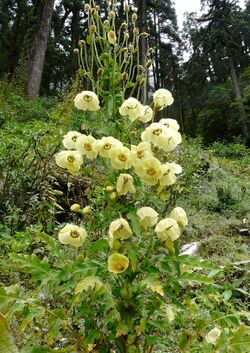Biology:Meconopsis autumnalis
| Meconopsis autumnalis | |
|---|---|

| |
| Meconopsis autumnalis in the wild | |
| Scientific classification | |
| Kingdom: | Plantae |
| Clade: | Tracheophytes |
| Clade: | Angiosperms |
| Clade: | Eudicots |
| Order: | Ranunculales |
| Family: | Papaveraceae |
| Genus: | Meconopsis |
| Species: | M. autumnalis
|
| Binomial name | |
| Meconopsis autumnalis P.A.Egan
| |
Meconopsis autumnalis, the Nepalese autumn poppy, is a yellow-flowered Himalayan poppy belonging to series Robustae, and is endemic to the Ganesh Himal range of central Nepal, where it was discovered in 2008 on a research expedition from the University of Aberdeen.[1] In addition to several morphological features, the species is characterised by its late flowering period (as reflected in the specific etymology), which has more than likely resulted in a barrier to gene flow and subsequent evolutionary divergence from the closely related and sympatric species Meconopsis paniculata.[2]
Specimens of M. autumnalis had twice previously been collected, by famous plant hunter J. D. A. Stainton on his 1962 expedition with S. A. Bowes Lyon to central Nepal,[3] and on the Flora of Ganesh Himal expedition undertaken by the University of Tokyo in 1994.[4] However, despite recognition as to the novelty of the plant implicated in Stainon's fieldnotes accompanying the species paratype (where it was described as 'easily distinguishable' from M. paniculata), it was not until new collections and field observations in 2008 that the true status of the plant as a new species was definitely realised. It was formally described in 2011.
Ecology
Meconopsis autumnalis grows in sub-alpine habitat commonly along stream margins, grassy alpine slopes or at edges and openings of Abies forest. Commonly associated herbaceous species include Rumex, Arisaema, Stellaria, Nepeta, Persicaria, Aster, Swertia, as well as dwarf shrubs such as Berberis, Rhododendron and Juniperus. The species ranges in elevation from 3300–4200 m, favouring stony, humus-rich soils. Similar to Meconopsis manasluensis and other Meconopsis of Nepal, the species appears to exhibit a very limited geographic distribution, thus necessitating more in-depth conservation assessment. Flowering occurs in late July to September.
References
- ↑ Egan, P.A. (2010). Expedition Meconopsis. The Rock Garden 124: 46–61.
- ↑ Egan, P.A. (2011). Meconopsis autumnalis and M. manasluensis (Papaveraceae), two new species of Himalayan poppy endemic to central Nepal with sympatric congeners. Phytotaxa 20 47-56.
- ↑ Stainton, J.D.A. (1964). Notes on a journey in East and Central Nepal 1964 with brief notes on journeys in East Nepal 1956 and in Central Nepal in 1962. British Museum (privately published), 51 pp.
- ↑ Ohba, H. & Ikeda, H. (1999). A contribution to the flora of Ganesh Himal, Central Nepal (Nature and Culture, No. 5). University Museum-University of Tokyo, 84 pp.
External links
- Two new species of Himalayan poppy from Nepal - News briefing, School of Natural Sciences - Trinity College Dublin.
- Flora of Nepal - Coordinated by the Royal Botanic Garden Edinburgh and partners.
Wikidata ☰ Q2920797 entry
 |

